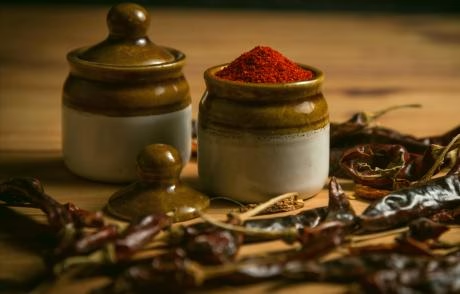When handling chili peppers, it only takes a moment to get your hands irritated, which is no fun. And rubbing your eyes can be even more disastrous. What precautions can you take before cutting chili peppers? If you do get a spicy hand, how should you treat it and relieve the pain?
Capsaicin in chili peppers causes redness, swelling, and heat.
Chili peppers contain capsaicin, which dilates the capillaries in the surface of the skin when it comes into contact with the skin, causing a red, swollen, and hot sensation similar to an inflammatory reaction.
Spiciness is a tactile sensation, not a taste sensation, so some people who are not used to spicy food do experience a “painful” sensation.
Because spiciness is a tactile sensation, there’s a saying that “spicy food tolerance can be trained.”
Typically, people who enjoy spicy food can gradually adapt to it and become more spicier. However, there’s a limit to how much spiciness the body can tolerate. Excessive spiciness can damage mucous membranes and cause inflammation.
Why does spicy food cause sweating?
The pain associated with spicy food triggers the brain to release analgesic substances that stimulate saliva production, inhibit bacterial growth, and increase blood circulation and gastrointestinal motility. This is why spicy food can easily cause sweating and a feeling of heat.
After the burning sensation subsides, you may experience a soothing sensation, leading some people to believe that spicy food can boost their spirits. Previous studies have confirmed the health benefits of capsaicin, including antioxidant properties and blood vessel protection. New research has also found that consuming spicy food can reduce mortality and the risk of death from cardiovascular disease.
How to properly cut chili peppers?
- Before cutting chilies, apply oil to your hands or wear gloves to prevent direct contact between your skin and the chilies.
- Cut the washed chilies open, remove the seeds with the tip of a knife, rinse, and then cut into desired shapes.
- Wash the used knife and cutting board, remove the gloves, and then wash your hands with soap to prevent the burning sensation of chili peppers.
- When handling chilies, avoid contact with your eyes or face to prevent a painful burning sensation.
What should you do if your hands have been burned by chili peppers?
When eating spicy food or getting your hands on chili peppers, applying ice water won’t relieve the pain.
- Cold milk: Most people drink milk to relieve spiciness, and this can also be applied to the affected skin. Capsaicin is fat-soluble and can penetrate the casein in milk, reducing the amount of capsaicin on the receptors, thereby relieving the pain.
- Oil: Rubbing your hands with cooking oil can alleviate discomfort.
- Aloe vera gel: Aloe vera gel, commonly used to soothe after sunburn, can also help relieve pain.
If the pain persists after treatment, seek medical attention if it’s severe.
Make your own chili sauce or oil for longer shelf life.
Fresh chilies can be stored at room temperature for about 5-7 days. Alternatively, wash, dry, and freeze them in a ziplock bag for up to a month. You can also make chili oil or sauce for longer shelf life and convenience.


Leave a Reply